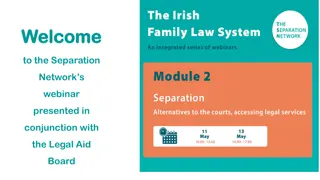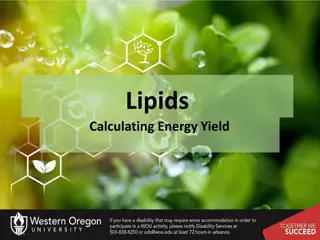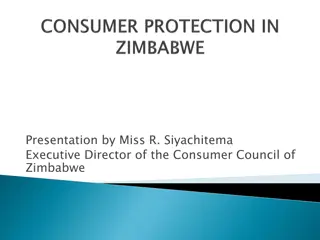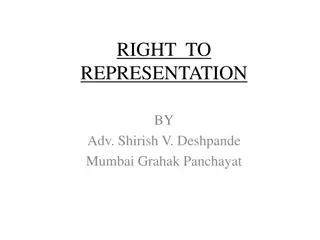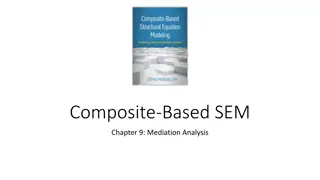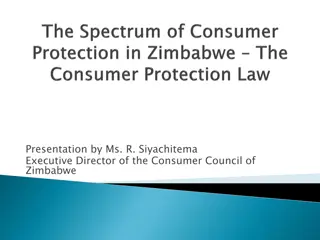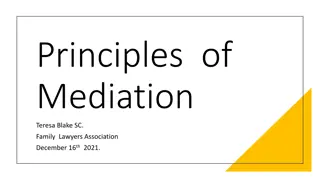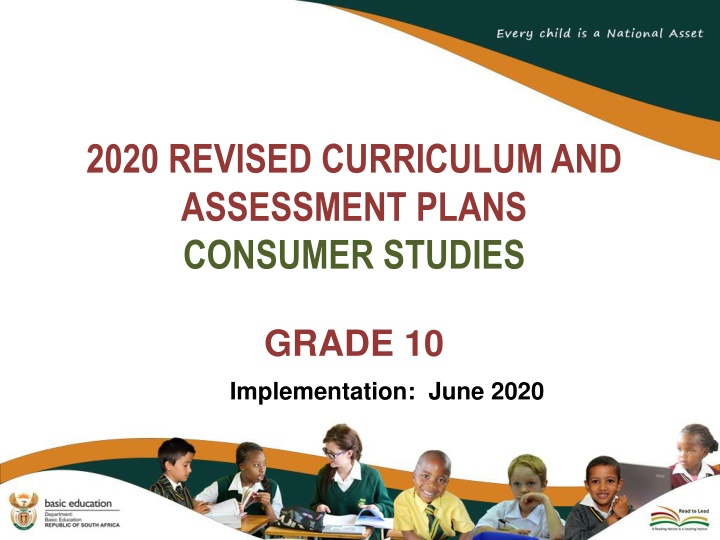
2020 Revised Curriculum and Assessment Plans for Consumer Studies Grade 10
"Discover the amendments and updates in the 2020 revised curriculum and assessment plans for Consumer Studies Grade 10, ensuring a structured approach to teaching essential consumer-related topics. Topics include consumer rights, sustainable consumption, marketing, financial aspects, and more."
Download Presentation

Please find below an Image/Link to download the presentation.
The content on the website is provided AS IS for your information and personal use only. It may not be sold, licensed, or shared on other websites without obtaining consent from the author. If you encounter any issues during the download, it is possible that the publisher has removed the file from their server.
You are allowed to download the files provided on this website for personal or commercial use, subject to the condition that they are used lawfully. All files are the property of their respective owners.
The content on the website is provided AS IS for your information and personal use only. It may not be sold, licensed, or shared on other websites without obtaining consent from the author.
E N D
Presentation Transcript
2020 REVISED CURRICULUM AND ASSESSMENT PLANS CONSUMER STUDIES GRADE 10 Implementation: June 2020
Presentation Outline 1.Purpose 2.Amendments to the Content Overview for the Phase; 3.Amendments to the Annual Teaching Plan; 4.Amendments School Based Assessment (SBA) 5.Conclusion
1. Purpose To mediate the amendments of the trimmed and re-organised 2020 Annual including School Based Consumer Studies, Grade 10 for implementation in June 2020 as stipulated in Circular S2 of 2020. To ensure that meaningful teaching proceeds during the remaining teaching time as per the revised school calendar. To assist teachers with guided pacing and sequencing of curriculum assessment. Teaching Assessment Plan for content and
1. Purpose (continued) To enable teachers to cover the essential core content /skills in each grade within the available time. To assist teachers with planning for the different forms of assessment. To ensure learners are adequately prepared for the subsequent year/s in terms of content, skills, knowledge, attitudes and values
2. Amendments to the Content Overview for the Phase
Summary: Amendments to the Content Overview for the Phase Grade 10 Grade 11 Grade 12 *Trimmed * Reorganised *No amendment The Consumer Consumer needs and wants. Consumer rights and responsibilities. Decision making. Sustainable consumption. Factors influencing consumer buying behaviour. Evaluating food, clothing and furniture outlets and restaurants. Marketing. Marketing strategies. The 5P marketing mix model. The AIDA model. The Consumer Income and expenditure of South African families. The household budget. Banking and payment methods. Consumer protection policies and practices. Consumer organisations. Channels for consumer complaints. The Consumer Financial and contractual aspects consumers should take note of. Taxes, interest rates and inflation. Sustainable consumption of water and electricity. Responsibilities of municipalities and communities.
Summary: Amendments to the Content Overview for the Phase Grade 10 Grade 11 Grade 12 *Trimmed * Reorganised *No amendment Food and Nutrition Food practices of consumers. Energy and nutritional requirements of consumers. South Africa s food-based dietary guidelines. The six food groups in the SA food guide pyramid. Nutrients and their functions in food groups. Daily meal planning. Food hygiene, food safety, food spoilage, food storage, waste control and recycling. Kitchen pests. Food and Nutrition Functions and sources of nutrients. Nutritional and energy needs of different consumer groups. Food contamination and food hazards. Food and Nutrition Prevention and management of nutritional and food-related health conditions. Food-borne diseases. Food additives. Food labelling as a source of information. Food-related consumer issues.
Summary: Amendments to the Content Overview for the Phase Grade 10 Grade 11 Grade 12 *Trimmed * Reorganised *No amendment Design elements and principles Design elements and principles Design elements (line, shape, form, space, colour and texture). Design principles (proportion, balance, rhythm, harmony, emphasis). Colour (terminology, colour wheel, colour combinations). Application in clothing and interior finishes. Design elements and principles Application of design elements and principles when planning a wardrobe.
Summary: Amendments to the Content Overview for the Phase Grade 10 Grade 11 Grade 12 *Trimmed * Reorganised *No amendment Fibres and Fabrics The origin, properties and use of fibres and fabrics in clothing and furnishings: natural fibres, regenerated cellulose fibres, synthetic polymer fibres, textile blends. The choice of textiles for clothing and soft furnishing. Fibres and Fabrics Appearance, properties and uses of fabric construction techniques for clothing and furnishings. Fabric properties and finishes for clothing and household textiles. **Note: note the trimming of topics on the ATP.
Summary: Amendments to the Content Overview for the Phase Grade 10 Grade 11 Grade 12 *Trimmed * Reorganised *No amendment Clothing Clothing The young adult s choice of suitable clothing. ** Note trimming on ATP Fashion and appearance in the world of work. The fashion cycle and current fashion trends for young adults. Planning a basic wardrobe. Consumer issues regarding clothing and textiles Adaptive clothing for the disabled.
Summary: Amendments to the Content Overview for the Phase Grade 10 Grade 11 Grade 12 *Trimmed * Reorganised *No amendment Housing and Interior Factors influencing housing decisions. Design features in housing and interiors: ergonomics and universal design. Enabling housing environments for the disabled. Housing and Interior Space planning. Choice of furniture. Evaluation criteria when purchasing furniture. Housing and Interior Different housing acquisition options. Financing related to buying a house. Choice of household appliances. Finances and contracts related to buying furniture and household appliances.
Summary: Amendments to the Content Overview for the Phase Grade 10 Grade 11 Grade 12 *Trimmed * Reorganised *No amendment Entrepreneurship What is entrepreneurship? Calculate the cost of products. Choice of items for small- scale production. Planning for small-scale production. Entrepreneurship The choice, production and marketing of homemade products / items. Concept testing and needs identification. Marketing: the marketing process. Core principles of marketing. Production: production costs. Determine the selling price Entrepreneurship Moving from an idea to the production and marketing of a product. Factors influencing efficient production. Requirements for quality products. Develop a marketing plan, according to the 5P marketing strategy. Evaluate the sustainable profitability of an enterprise.
3. Amendments to the Annual Teaching Plan
Summary: Reorganisation/Trimming of content topics Topics re-organised The Consumer Food and Nutrition Housing and Interior Entrepreneurship Fibres and Fabrics Clothing Topics trimmed The Consumer Food and Nutrition Housing and Interior Entrepreneurship Fibres and Fabrics Clothing
Summary: Amendment to the weighting of content topics Weighting of content topics are revised for the November 2020 paper for Grade 10 Consumer Studies.
Gr 10 Summary: Content / Topics Amended Content/Topics Food and Nutrition Food Hygiene Term Term 2 Week 2 Amendment= Reorganisation Moved from Term 2 Week 2 to Term 2 Week 1. Moved from Term 2 Week 3 to Term 2 Week 2. Term 2 Week 3 Food and Nutrition Food storage Moved from Term 2 Week 5 to Term 2 Week 3. Term 2 Week 5 The Consumer Marketing Moved from Term 2 Week 5 to Term 2 Week 4. Term 2 Week 6 The Consumer The 5 P Marketing Mix Moved from Term 2 Week 5 to Term 2 Week 4. Term 2 Week 7 The Consumer The AIDA Model
Gr 10 Summary: Content/Topics Amended Content/Topics Fibres and Fabrics Regenerated Cellulose Fibres Term Term 3 Week 5 Amendment= Reorganisation Moved from Term 3 Week 5 to Term 3 Week 4 Moved from Term 3 Week 7 to Term 3 Week 4 Term 3 Week 7 Fibres and Fabrics The choice of textiles for clothing and soft furnishing items according to fashion, suitability, fibre properties, price and environmental concerns Moved from Term 3 Week 8 to Term 3 Week 5 Term 3 Week 8 Clothing The young adult s choice of suitable clothing. Moved from Term 3 Week 10 to Term 3 Week 7 Term 3 Week 10 Clothing Adaptive clothing for people with disabilities
Gr 10 Summary: Content / Topics Amended Content/Topics Entrepreneurship Choice of items for small-scale production Term Term 4 Week 6 Amendment= Reorganisation Moved from Term 4 Week 6 to Term 4 Week 1 Moved from Term 4 Week 6 to Term 4 Week 2 Term 4 Week 6 Entrepreneurship Planning for small-scale production Moved from Term 4 Week 1 and 2 and merged into Term 4 Week 3 Term 4 Week 1-2 Housing and Interior Factors influencing housing decisions Moved from Term 4 Week 3 to Term 4 Week 4 Term 4 Week 3 Housing and Interior Design features of housing and interiors: Ergonomics in design
Gr 10 Summary: Content / Topics Amended Content/Topics Term Food and Nutrition Food storage Amendment=Trimmed Remove: Recycling of household waste. (Was dealt with In Term 1 Week 3: Sustainable consumption) Term 2 Week 4 Content topics removed to accelerate time. Removed: Week 4: Influence of marketing and promotion on consumer behaviour: shop layout and displays. Term 2 Week 3 Term 2 Week 4 The Consumer Dining out in restaurants Term 2 Week 7 The Consumer The AIDA Model Term 3 Week 2 Entrepreneurship Costing Removed: Conversions of ingredients where applicable: volume to mass and vice versa. Develop and cost a shopping list
Gr 10 Summary: Content / Topics Amended Content/Topics Term Amendment= Trimmed Term 3 Week 3;4;5 Removed: Properties from all three fibres. Fibres and Fabrics Natural Fibres Regenerated Cellulose fibres Synthetic Polymer Fibres Term 3 Week 5 Fibres and Fabrics Regenerated Cellulose fibres Remove: lyocell, acetate Term 3 Week 6 Removed: The properties and uses of leather and leather substitutes Identify and handle different fabrics. Fibres and Fabrics Leather and Leather substitutes Term 3 Week 7 Removed: Application of fibre and fabric knowledge in advising consumers on the purchase of clothing and/or furnishing items. Fibres and Fabrics Application of fibre and fabric knowledge in advising consumers on the purchase of clothing and/or furnishing items.
Gr 10 Summary: Content / Topics Amended Term Term 3 Week 9 Amendment=Trimmed Remove: Care and maintenance of clothing to retain appearance and physical comfort. Content/Topics Clothing The young adult s choice of suitable clothing
4. Amendments School Based Assessment (SBA)
Summary: Grade 10 Revised Programme of Assessment Term 1 Term 2 Term 3 Term 4 Task 1 March Test 100 % Task 3 SBA September Test 75 % Term 1+2+3 = 225 ( 2.25) to convert to 100 Practical Skills Test (Techniques and skills applied in Term 1 are added to the PAT in Term 4=25 ) Task 2 Task 4 PAT (ONE) Task 100 Two (2) Practical Lessons 25% Two (2) Practical Lessons 25% November Examination 100 marks (Convert to 200) 400 4 100 100 25 100
Summary: Grade 11 Nov Examination Structure Questions Content Mark allocation Short Questions (all topics) 1 20 The Consumer 2 20 Food and Nutrition 3 20 Clothing 4 15 Housing 5 15 Entrepreneurship 6 10 Convert the total out of 100 marks to 200 marks 100
Summary: Revised Practical Assessment Task (PAT) The original PAT consists of: PAT 1 100 marks PAT: One Practical Examination (100 marks) Weighting of marks not affected. SKAV assessed are standardised. The PAT is amended to manage social distancing and acceleration of time.
Conclusion SBA A uniform, standardised approach is used across Grade 10-12 in Consumer Studies. No important aspect of the Grade 12 curriculum is compromised. Re-organisation, maintains and supports the foundational principles of the National Curriculum Statement (NCS) as stated for Consumer Studies. The allocated time on the revised ATP is realistic to teach content/ activities and assessment and are aligned to the available time. The ATP exposes learners to a variety of forms of assessment. The amended School Based Assessment (SBA) aligns to the content and time available. Informal assessment focuses on the principles of assessment for learning in the context of specific or a combinations of topics. Informal activities prepare the learner for the formal assessment and final NSC examinations. PAT The amendment for the Gr 10 PAT aligns to the time available. Social distancing requirements are adhered to.
Contact Details Name: Magda van Pletzen CES: Services Subjects Department of Basic Education Tel: 0828264217 Email: vanpletzen.M@dbe.gov.za




